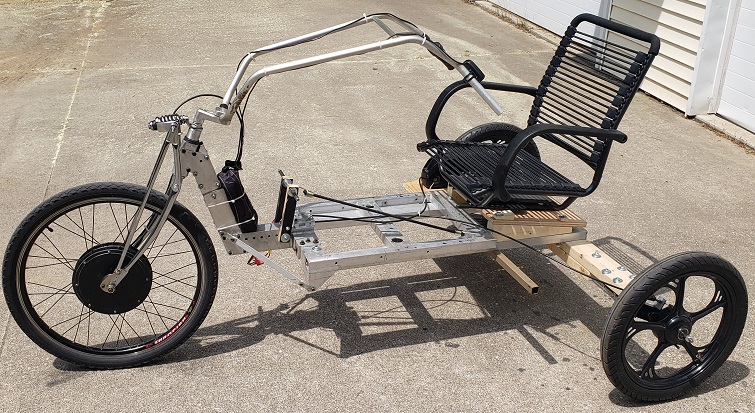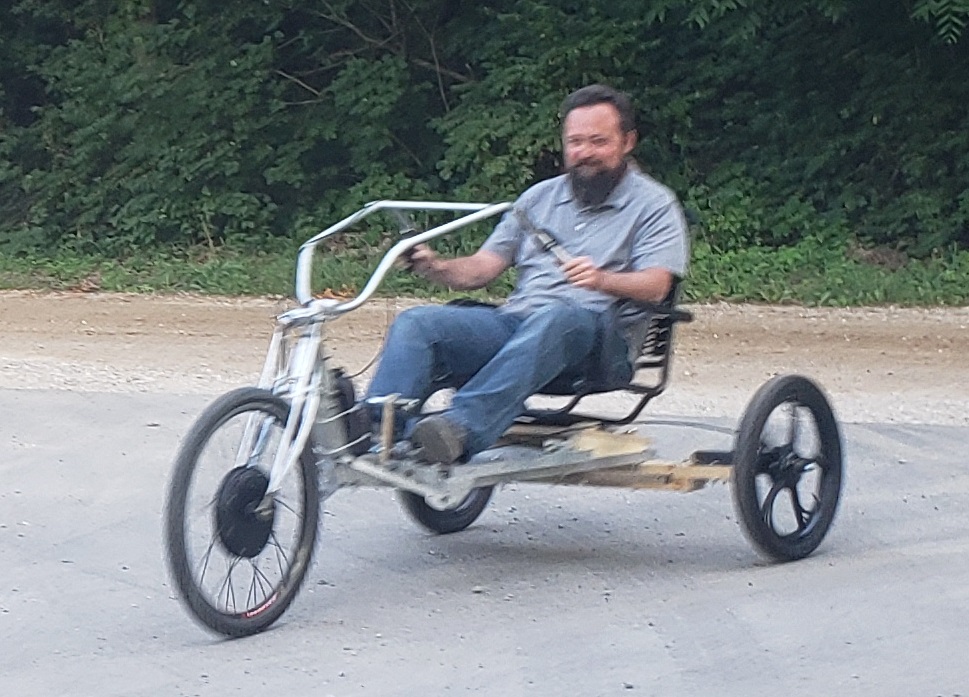EVOLUTION OF THE DREAM (January 2010)
For the last 20 years, our company founder (Kraig Schultz), has been dreaming about a vehicle that would make commuting to work inexpensive and fun for the common man. The vehicle would be lightweight, aerodynamic and easy to work on. In recent years, Schultz Engineering, LLC (SE, LLC) has made it a goal to get a vehicle of this kind into production. SE, LLC is developing alliances with partner companies to produce designs and components for this
Personal Transportation Vehicle (PTV-1) tm.
The PTV-1 vehicle will be designed to be modular with connection points of each portion well defined, so that parts of the vehicle (wheels, suspension, body, transmission, engine, etc.) can be produced by the people most qualified to build them and swapped out by the end user at any time and resold, reused, or recycled. The manufacturer wins (more customers), the end user wins (lower prices, more variety, better value) and the whole system works without large investment by any one party.
With this in mind, the PTV-1 might become an open source vehicle. The design could be open sourced like Linux, and the production could be standardized/globalized by open architecture like the IBM compatible PC (via a standardized design, datums and connection points), and knowledge and improvements facilitated by a WikiPedia-like database.
Another option could include licensing the design and production of PTV-1 components for a nominal fee. For example, SE, LLC might allow any designer or manufacturer in the world to badge their product as "PTV-1 compatible" for $1 or 1%. (There might be a higher license fee for a "PTV-1 tested" part. But, the testing and rating could be left up to the Wiki or other on-line rating systems like are used on E-bay).
|
2010 Design Criteria- The PTV-1tm has the following design goals:
|
|
And this leaves us, right where we are. Building proto-types, and developing a really good working design. In the pictures below, you will see some of the ideas produced by SE, LLC in the last three years to prove out concepts that may be incorporated into the PTV-1tm. The Electric Motorcycle Conversion
   The Sail Trike Human, Wind, Electric Hy-Brid Concept    Some Reverse Trike Experiments         Multi-Position Motorcycle Setups  Multi-Position Tilting Trike Proto-type    |
Tilting Delta Trike Prototype (2010 Concept Vehicle) Click here, to learn about the DELTA-12. (www.schultzengineering.us/delta-12.htm) |
Delta-11 Motorcycle (2011-2017 Concept Vehicle Project) Click here, to learn about the DELTA-11 project. (www.schultzengineering.us/delta-11.htm) |
|
Ford Festiva Conversion & Solar Projects (2014 -2020) Click here, to learn about the Ford Festiva Conversion project. (www.schultzengineering.us/festiva.htm) Click here, to learn about our solar PV projects. (www.schultzengineering.us/energy-3.htm) |
|
Nissan Leaf Projects (2018-2021) Click here, to learn about our Nissan Leaf projects. (www.schultzengineering.us/delta-11-18.htm) |
Portugal Vehicle Project (2018-2021)  Click here, to learn about the Portugal Vehicle project. (https://tugainnovations.com/) |

I am working to form a design collaborative to build a hyper-efficient vehicle as an open sourced project for the purpose of making transportation vehicles 10X to 100X less energy and pollution intensive.



January to July 2025: Electric Trike, Built from Spare Parts
These days, most of my "free-time" is spent working on big-picture transitions—building parallel governance systems, regenerative communities, and exploring pathways toward a post-consumer society. But when I get a moment, I still love to make things.
This vehicle is an electric delta trike, built from my stash of spare parts. The photos include me on a scale mock-up before fabricating the actual frame, and a few pictures of trike as it was test-ridden to verify a few assumptions.
Inspiration
This build was inspired by the classic road cart—a lightweight carriage that helped Billy Durant dominate the horse-drawn mobility market, eventually leading to the founding of General Motors. Like the road cart, this trike is intended to be: Lightweight, Extremely agile, Comfortable to ride, Fully recyclable
Phase 1: Proof of Concept
Goal: Build without spending money.
Method: Constructed almost entirely from spare parts I had on hand, except for: A few longer bolts, A used office chair that uniquely uses bungee cords instead of foam.
Total out-of-pocket cost: Less than $200
Phase 2: Testing - I tested two hub motors (500W and 1000W) and multiple rear wheel configurations on local roads.
Conclusions:
Positives
Ergonomics:
The bungee-cord suspended seat, with armrests and natural handlebar placement, created a remarkably comfortable ride. Full upper-body relaxation was possible, and head/neck posture was ideal for enjoying the scenery.
Carefree Riding:
Compared to two-wheeled bikes, there's far less concern about road hazards causing loss of control. It feels more like the comfort of a car—without the bulk.
Steering and Tranquility:
The delta configuration allows for smooth, light steering—much less steering input force than a reverse trike. No stress, no balancing act. Your mind and muscles are freed from constant micro-adjustments required on a two-wheeled bike.
Front Suspension:
A springer fork made the front end surprisingly smooth and contributed to the comfort.
Motor Power:
The 500W motor was underpowered for the heavier frame. A 1000W hub motor worked well and offered acceptable acceleration.
Negatives
Rear Suspension Too Stiff:
The rubber torsional axles I had in stock are too stiff. Alternatives to explore: A torsional axle with a softer compound, and/or, swingarms with adjustable coil-over shocks, and/or, and/or, Lower air pressure or tires with more cushion with no mechanical suspension (simpler and lighter but more rolling resistance?), and/or, Solid rear axle for simplicity and testing tire-based damping
Width:
The prototype was wider than ideal. I didn’t complete testing at narrower widths, but this is essential. Narrower designs are safer when sharing the road with modern drivers who have little patience for slower moving “obstructions.”
Front Wheel Traction:
The front-wheel drive lost traction under load on slippery surfaces during acceleration. Ideas: Add rear-wheel assist (three-wheel drive) with a traction sensor? Increase front-wheel weight or reduce rear-frame weight - allowing traction to weight ratio to improve.
Braking and Torque Steer:
Needs further testing and refinement. Perhaps with a heavier front wheel and excellent braking on front wheel, rear brakes are less needed, or only needed for extra stopping power and parking brakes?
Human Drive System:
This version didn't have it due to low budget, but looking forward to having this for the exercise and efficiency of it.
Next Steps
(If continuing the project at all, because honestly, if my destination is beyond walking distance, I must reconsider the trip if I want the web of life to survive!)
Build a lighter frame (or purchase a used recumbent trike), Integrate a human-powered drivetrain, and retrofit with this a comfortable bungee-cord office chair.
Closing Thought
This is more than just a hobby project—it's a meditation on what transportation could be in a more sane civilization. It's not about speed or status. It's about joy, simplicity, and staying in harmony with the ecosystems we depend on. And, wondering if it is not just a transitional step back to Durant's horse drawn version.